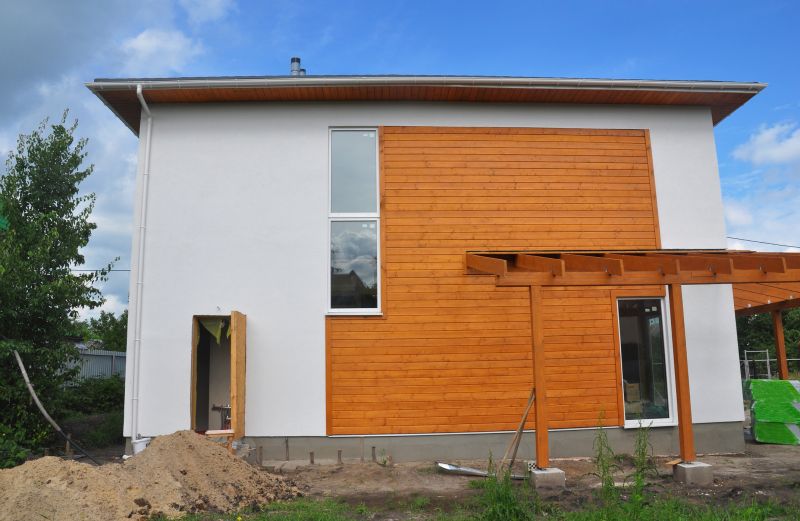Expert Picks For Essential Wood Cladding Installation Products
Find out which tools and materials professionals rely on for efficient and precise wood cladding installations.
 Installing wood cladding can dramatically enhance the aesthetic appeal and structural character of a building or outdoor space. The process involves selecting appropriate materials and products that ensure durability, ease of installation, and a polished finish. Various products are available to facilitate different styles, from traditional to modern, and to suit diverse environmental conditions. Proper selection of these products can help achieve a seamless and long-lasting cladding system.
Installing wood cladding can dramatically enhance the aesthetic appeal and structural character of a building or outdoor space. The process involves selecting appropriate materials and products that ensure durability, ease of installation, and a polished finish. Various products are available to facilitate different styles, from traditional to modern, and to suit diverse environmental conditions. Proper selection of these products can help achieve a seamless and long-lasting cladding system.
Top Overall Option
Wood Cladding Fastening System
A comprehensive fastening system designed specifically for wood cladding installations, including corrosion-resistant nails, screws, and anchors. This product type offers versatility for various timber types and installation methods, providing a secure and durable attachment. Its compatibility with different substrates and ease of use make it a preferred choice for both professionals and DIY enthusiasts seeking reliable results.
Types of Products For Wood Cladding Installations
Wood Cladding Nails
Specialized nails designed for securing wood panels, available in various lengths and coatings to suit indoor or outdoor use.
Wood Screws
Heavy-duty screws that provide strong attachment points, often with weather-resistant coatings for outdoor applications.
Adhesive Sealants
Flexible sealants formulated for bonding wood panels and sealing joints to prevent water ingress and improve aesthetic finish.
Cladding Spacers
Tools used to maintain consistent gaps between panels, ensuring uniformity and proper airflow.
Weatherproof Coatings
Protective finishes that shield wood surfaces from moisture, UV rays, and temperature fluctuations.
Expansion Joints
Components that accommodate movement and prevent cracking or warping of the cladding panels.
Surface Prep Tools
Sanding blocks, brushes, and cleaners used to prepare wood surfaces for installation and finishing.
Corner Trim Pieces
Decorative and protective trims for edges and corners to enhance appearance and durability.
Underlayments
Protective layers placed beneath cladding to improve insulation and moisture management.
Fastening Tools
Power drills, nail guns, and screwdrivers designed for efficient attachment of cladding panels.
Drainage Mats
Materials installed behind cladding to facilitate water runoff and prevent moisture buildup.
Decorative Panels
Pre-finished or untreated panels used for aesthetic accents or feature walls.
Thermal Insulation Boards
Insulation panels that improve energy efficiency when installed behind wood cladding.
Fastener Caps
Caps that cover screws or nails for a cleaner appearance and added protection against corrosion.
Protective Films
Films applied to wood surfaces during installation to prevent scratches and damage.
Popular Choices
Widely used for securing wood panels, available in various finishes and sizes.
Commonly chosen for outdoor applications due to their corrosion-resistant properties.
Popular for bonding panels and sealing joints to prevent moisture penetration.
Frequently used to ensure consistent gaps and proper panel alignment.
Commonly selected for outdoor projects to extend the lifespan of wood cladding.
Essential for large installations to accommodate movement and prevent damage.
Popular for quick and efficient fastening during large-scale installations.
Chosen for finishing edges and enhancing visual appeal.
Often used behind cladding to improve moisture management.
Increasingly popular for outdoor facades to manage water flow.
Selected for a clean look and added corrosion protection.
When choosing products for wood cladding installations, it is essential to consider factors such as material compatibility, weather resistance, and ease of handling. Tools and accessories like fasteners, adhesives, and sealants play a crucial role in ensuring the integrity of the installation. Additionally, specialized products like spacers and protective coatings can help maintain the visual appeal and longevity of the cladding.
The range of available products includes different types of timber, composite materials, and finishing products that can be tailored to specific project requirements. For outdoor applications, selecting weatherproof and rot-resistant options is vital, while indoor installations may prioritize aesthetic finishes and ease of maintenance. Understanding the variety and purpose of these products can help homeowners and professionals achieve the desired outcome efficiently.
Proper preparation, including surface cleaning and measurement, combined with the right product selection, can streamline the installation process and improve the quality of the final result. Whether working on a small residential project or a large commercial facade, having a comprehensive understanding of the available products can aid in making informed decisions that align with project goals and budget constraints.
Key Buying Considerations
- Compatibility with the type of wood or composite material used.
- Weather resistance and suitability for outdoor or indoor applications.
- Corrosion resistance of fasteners and metal components.
- Ease of installation and whether specialized tools are required.
- Compatibility of adhesives and sealants with the wood surface.
- Availability of different sizes and lengths to match panel thickness.
- Aesthetic finish options, including coatings and trims.
- Flexibility and movement accommodation features such as expansion joints.
- Protection against moisture, UV rays, and temperature fluctuations.
- Durability and longevity of the product under expected conditions.
- Ease of maintenance and cleaning after installation.
- Environmental conditions of the installation site, such as exposure to salt or chemicals.
- Cost considerations and overall project budget.
- Availability of complementary products like spacers, underlayments, and trims.
- Manufacturer or supplier reputation for quality and support.
